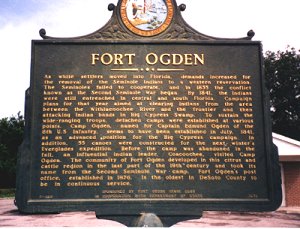
return to History

As white settlers moved into Florida, demands increased for the removal of the Seminole Indians to a western reservation. The Seminoles failed to cooperate, and in 1835 the conflict known as the Second Seminole Indian War began. By 1841, the Indians were still entrenched in central and south Florida. Campaign plans for that year aimed at clearing Indians from the area between the Withlacoochee River and the frontier and the attacking Indian bands in Big Cypress Swamp. To sustain the wide-ranging troops, detached camps were established at various points. Camp Ogden, named for Captain Edmund Ogden of the 8th US Infantry, seems to have been established in July 1841, as an advanced position for the Big Cypress campaign. In addition, 55 canoes were constructed for the next winter's Everglades expedition. Before the Camp was abandoned in the fall, an influential Indian leader, Coacoochee, visited Camp Ogden. The community of Fort Ogden developed in this citrus and cattle region in the last part of the 19th century and took its name from the Second Seminole War camp. Fort Ogden's post office, established in 1876, is the oldest in Desoto County to be in continuous service.